2022 TOYOTA SUPRA change time
[x] Cancel search: change timePage 229 of 498
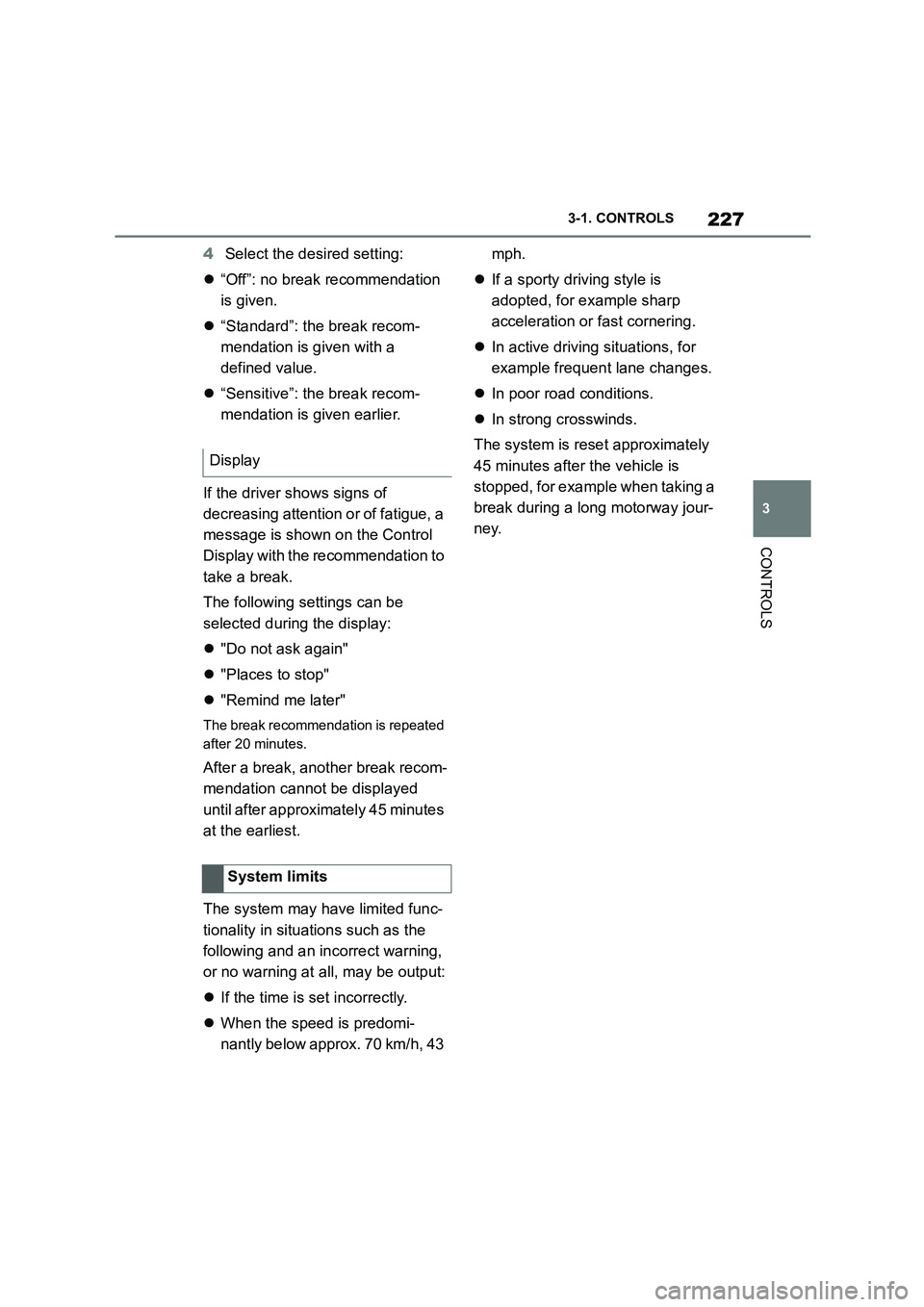
227
3
3-1. CONTROLS
CONTROLS
4 Select the desired setting:
“Off”: no break recommendation
is given.
“Standard”: the break recom-
mendation is given with a
defined value.
“Sensitive”: the break recom-
mendation is given earlier.
If the driver shows signs of
decreasing attention or of fatigue, a
message is shown on the Control
Display with the recommendation to
take a break.
The following settings can be
selected during the display:
"Do not ask again"
"Places to stop"
"Remind me later"
The break recommendation is repeated
after 20 minutes.
After a break, another break recom-
mendation cannot be displayed
until after approximately 45 minutes
at the earliest.
The system may have limited func-
tionality in situations such as the
following and an incorrect warning,
or no warning at all, may be output:
If the time is set incorrectly.
When the speed is predomi-
nantly below approx. 70 km/h, 43
mph.
If a sporty driving style is
adopted, for example sharp
acceleration or fast cornering.
In active driving situations, for
example frequent lane changes.
In poor road conditions.
In strong crosswinds.
The system is reset approximately
45 minutes after the vehicle is
stopped, for example when taking a
break during a long motorway jour-
ney.
Display
System limits
Page 235 of 498
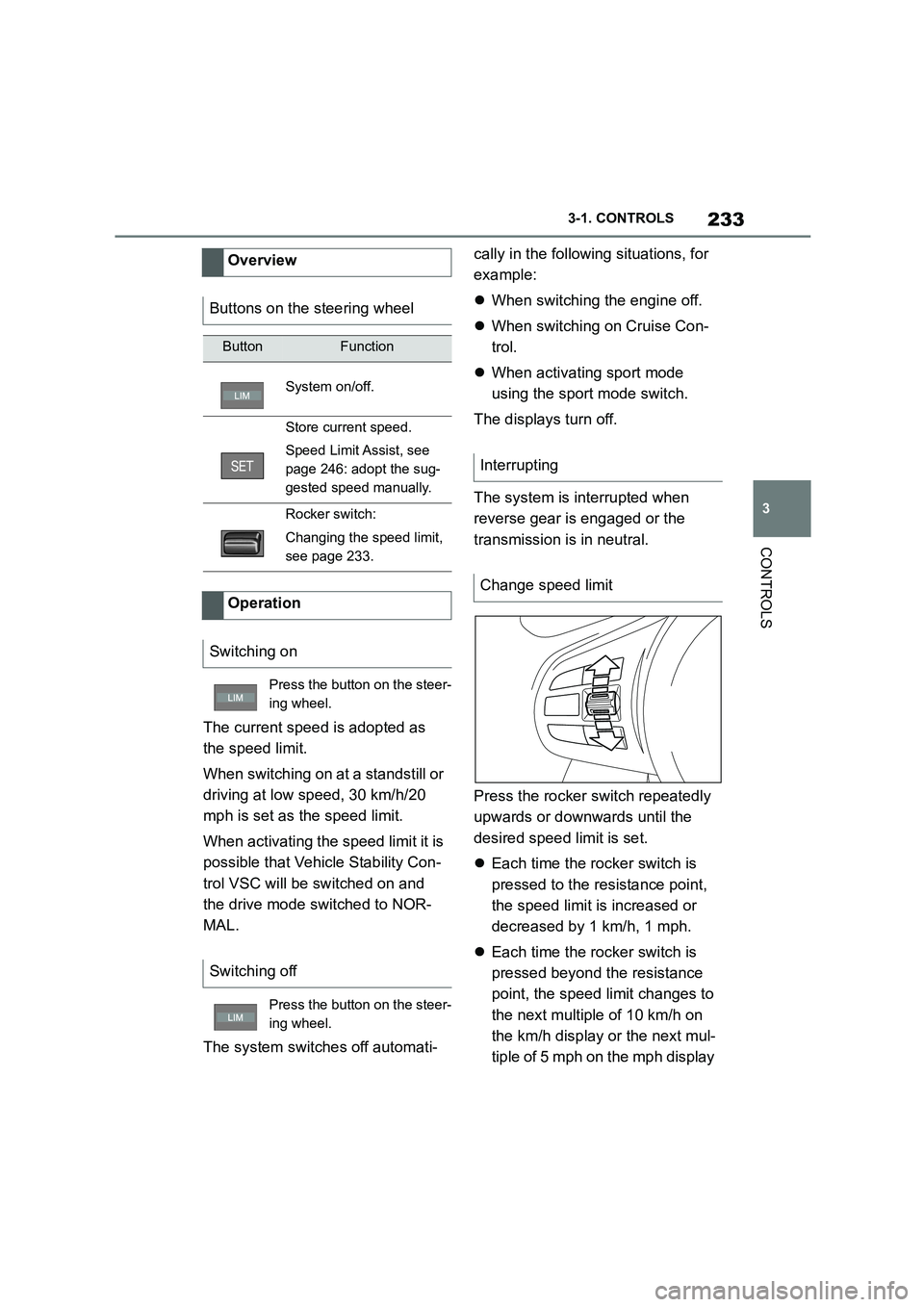
233
3
3-1. CONTROLS
CONTROLS
The current speed is adopted as
the speed limit.
When switching on at a standstill or
driving at low speed, 30 km/h/20
mph is set as the speed limit.
When activating the speed limit it is
possible that Vehicle Stability Con-
trol VSC will be switched on and
the drive mode switched to NOR-
MAL.
The system switches off automati-
cally in the followi ng situations, for
example:
When switching the engine off.
When switching on Cruise Con-
trol.
When activating sport mode
using the sport mode switch.
The displays turn off.
The system is interrupted when
reverse gear is engaged or the
transmission is in neutral.
Press the rocker switch repeatedly
upwards or downwards until the
desired speed limit is set.
Each time the rocker switch is
pressed to the resistance point,
the speed limit is increased or
decreased by 1 km/h, 1 mph.
Each time the rocker switch is
pressed beyond the resistance
point, the speed limit changes to
the next multiple of 10 km/h on
the km/h display or the next mul-
tiple of 5 mph on the mph display
Overview
Buttons on the steering wheel
ButtonFunction
System on/off.
Store current speed.
Speed Limit Assist, see
page 246: adopt the sug-
gested speed manually.
Rocker switch:
Changing the speed limit,
see page 233.
Operation
Switching on
Press the button on the steer-
ing wheel.
Switching off
Press the button on the steer-
ing wheel.
Interrupting
Change speed limit
Page 239 of 498
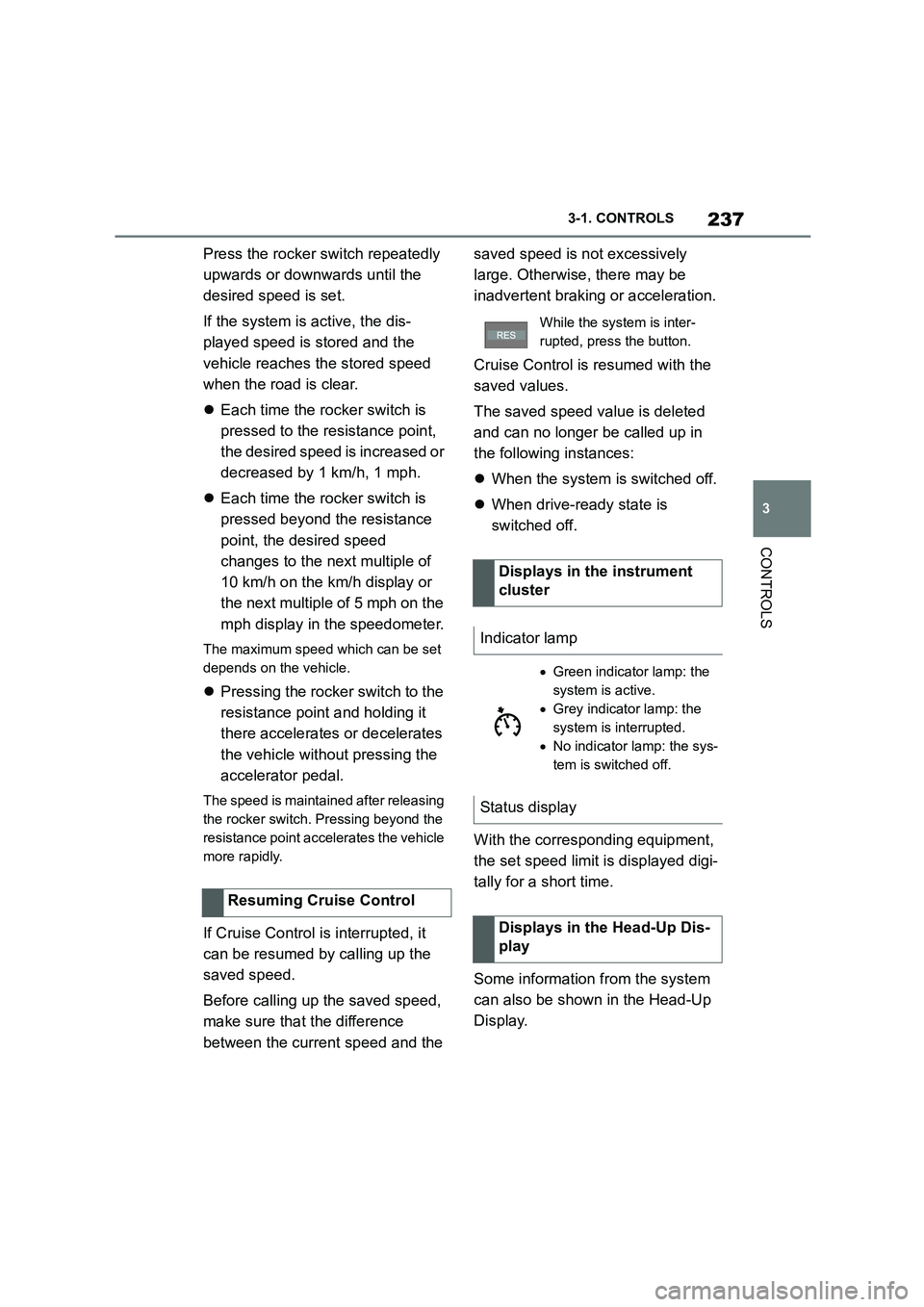
237
3
3-1. CONTROLS
CONTROLS
Press the rocker switch repeatedly
upwards or downwards until the
desired speed is set.
If the system is active, the dis-
played speed is stored and the
vehicle reaches the stored speed
when the road is clear.
Each time the rocker switch is
pressed to the resistance point,
the desired speed is increased or
decreased by 1 km/h, 1 mph.
Each time the rocker switch is
pressed beyond the resistance
point, the desired speed
changes to the next multiple of
10 km/h on the km/h display or
the next multiple of 5 mph on the
mph display in the speedometer.
The maximum speed which can be set
depends on the vehicle.
Pressing the rocker switch to the
resistance point and holding it
there accelerates or decelerates
the vehicle without pressing the
accelerator pedal.
The speed is maintained after releasing
the rocker switch. Pressing beyond the
resistance point acce lerates the vehicle
more rapidly.
If Cruise Control is interrupted, it
can be resumed by calling up the
saved speed.
Before calling up the saved speed,
make sure that the difference
between the current speed and the
saved speed is not excessively
large. Otherwise, there may be
inadvertent braking or acceleration.
Cruise Control is resumed with the
saved values.
The saved speed value is deleted
and can no longer be called up in
the following instances:
When the system is switched off.
When drive-ready state is
switched off.
With the corresponding equipment,
the set speed limit is displayed digi-
tally for a short time.
Some information from the system
can also be shown in the Head-Up
Display.
Resuming Cruise Control
While the system is inter-
rupted, press the button.
Displays in the instrument
cluster
Indicator lamp
Green indicator lamp: the
system is active.
Grey indicator lamp: the
system is interrupted.
No indicator lamp: the sys-
tem is switched off.
Status display
Displays in the Head-Up Dis-
play
Page 243 of 498
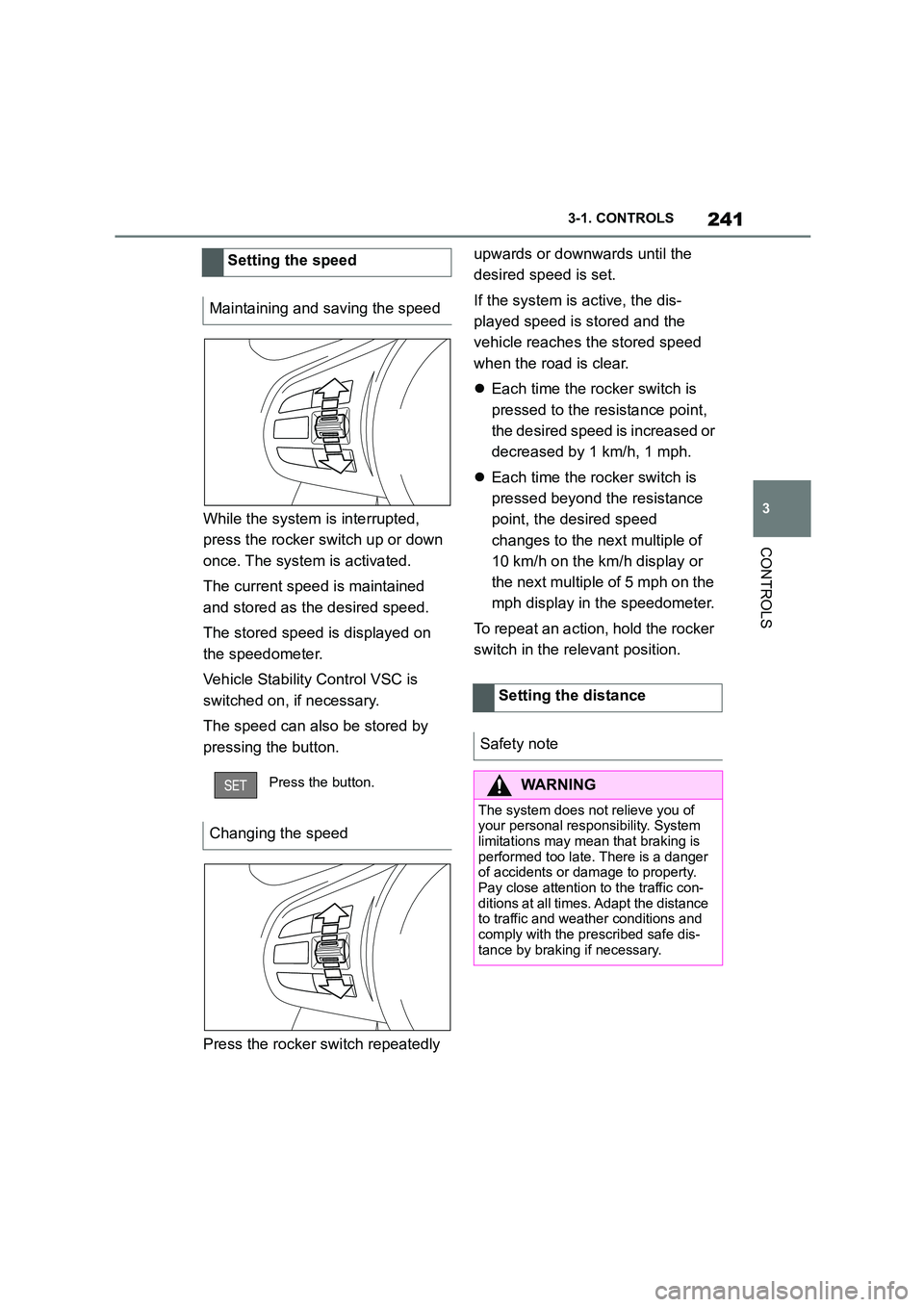
241
3
3-1. CONTROLS
CONTROLS
While the system is interrupted,
press the rocker switch up or down
once. The system is activated.
The current speed is maintained
and stored as the desired speed.
The stored speed is displayed on
the speedometer.
Vehicle Stability Control VSC is
switched on, if necessary.
The speed can also be stored by
pressing the button.
Press the rocker switch repeatedly
upwards or downwards until the
desired speed is set.
If the system is active, the dis-
played speed is stored and the
vehicle reaches the stored speed
when the road is clear.
Each time the rocker switch is
pressed to the resistance point,
the desired speed is increased or
decreased by 1 km/h, 1 mph.
Each time the rocker switch is
pressed beyond the resistance
point, the desired speed
changes to the next multiple of
10 km/h on the km/h display or
the next multiple of 5 mph on the
mph display in the speedometer.
To repeat an action, hold the rocker
switch in the relevant position.
Setting the speed
Maintaining and saving the speed
Press the button.
Changing the speed
Setting the distance
Safety note
WA R N I N G
The system does not relieve you of
your personal responsibility. System limitations may mean that braking is
performed too late. There is a danger
of accidents or damage to property. Pay close attention to the traffic con-
ditions at all times. Adapt the distance
to traffic and weather conditions and comply with the prescribed safe dis-
tance by braking if necessary.
Page 253 of 498

251
3
3-1. CONTROLS
CONTROLS
The approach of the vehicle to an
object is shown on the Control Dis-
play. Objects that are further away
are already displayed before an
acoustic signal is given.
The display appears as soon as
Parking Sensor is activated.
The recording range of the sensors
is shown in green, yellow and red if
obstacles are detected within the
range.
Driving path lines are displayed for
better estimation of the space
required.
If the rear-view camera image is
shown, it is possible to change over
to Parking Sensor or, if required, to
another view with obstacle mark-
ings:
1 If necessary, push the Controller
to the left.
2 For example "Parking sensors"
RCTA (Rear cross traffic alert) func-
tion, see page 256: depending on
the equipment, the Parking Sensor
display also warn s about vehicles
approaching from the sides at the
front and rear.
The emergency brake function of
Parking Sensor in itiates emergency
braking if there is an imminent risk
of a collision.
Due to the system limits, a collision
cannot be prevented under all cir-
cumstances.
The function is available at speeds
below walking speed when driving
or rolling in reverse.
Pressing the accelerator pedal
interrupts the braking intervention.
After emergency braking to a stop,
it is possible to continue a slow
approach to the obstacle. To
approach, lightly depress the accel-
erator.
If the accelerator is depressed
more firmly, the vehicle pulls away
as normal. Manual braking is possi-
ble at any time.
The system uses the ultrasonic
sensors of Parking Sensor and
Park Assistant.
Visual warning
Depending on the equipment
version: emergency braking
function, Parking Sensors
with emergency braking
function
Principle
General
Page 263 of 498
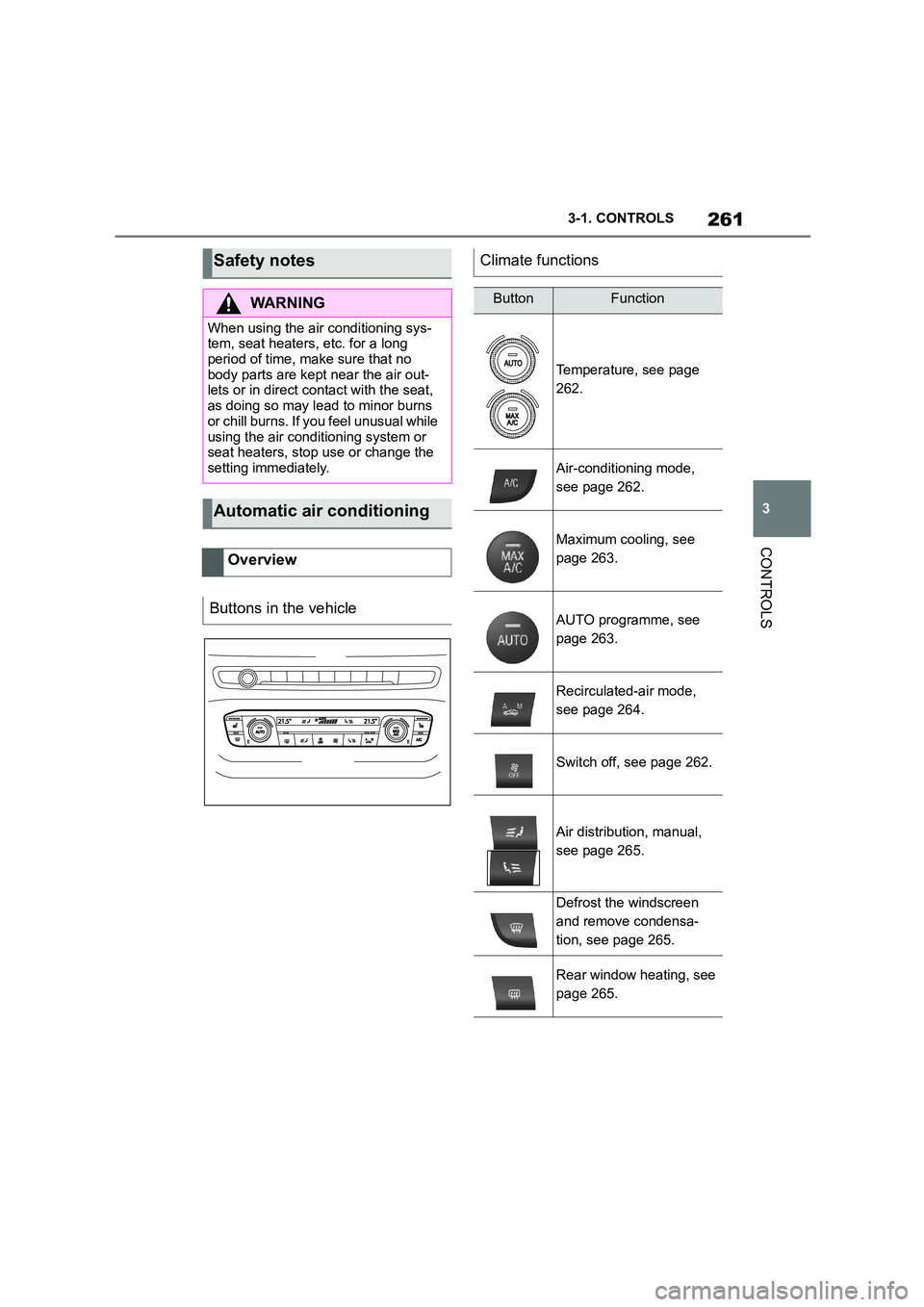
261
3
3-1. CONTROLS
CONTROLS
Safety notes
WA R N I N G
When using the air conditioning sys- tem, seat heaters, etc. for a long
period of time, make sure that no
body parts are kept near the air out- lets or in direct contact with the seat,
as doing so may lead to minor burns
or chill burns. If you feel unusual while
using the air conditioning system or seat heaters, stop use or change the
setting immediately.
Automatic air conditioning
Overview
Buttons in the vehicle
Climate functions
ButtonFunction
Temperature, see page
262.
Air-conditioning mode,
see page 262.
Maximum cooling, see
page 263.
AUTO programme, see
page 263.
Recirculated-air mode,
see page 264.
Switch off, see page 262.
Air distribution, manual,
see page 265.
Defrost the windscreen
and remove condensa-
tion, see page 265.
Rear window heating, see
page 265.
Page 266 of 498

2643-1. CONTROLS
body and into the footwell.
The cooling function, see page 262,
is switched on automatically in the
AUTO programme.
The AUTO programme is automati-
cally switched off when the air dis-
tribution is set manually.
If the air outside the vehicle has an
unpleasant odour or contains pol-
lutants, the air supply to the interior
of the vehicle can be shut off. The
air inside the vehicle is then recircu-
lated.
The LED is illumi nated when the
recirculated-air mode is switched
on.
When the left LED is illuminated:
Automatic recirculated air mode
If the pollution sensor detects pollutants
in the outside air, the air mode is auto-
matically changed from outside air
mode to recirculated air mode.
When the right LED is illuminated:
Recirculated air mode
The air in the cabin is continuously
recirculated.
When recirculated-air mode is
switched off, fresh air is directed
into the vehicle's interior.
The recirculated-air mode automat-
ically switches off after a given time
depending on the ambient condi-
tions, to avoid condensation.
The cooling function is also
switched on automatically to avoid
condensation.
Continuous use of recirculated-air
mode worsens air quality inside the
vehicle and increases condensa-
tion on the windows.
If there is condensation, shut down
recirculated-air mode or remove the
condensation, see page 265.
The air flow for air conditioning can
be set manually.
To be able to adjust the air flow
manually, first switch off the AUTO
programme.
The selected air flow is shown on
the display for automatic air condi-
tioning.
Recirculated-air mode
Principle
Operation
Press the button repeat-
edly to call up an operating
mode.
To adjust the air flow manu-
ally
Principle
General
Operation
Press left or right side of
button: reduce or increase
air flow.
Page 329 of 498
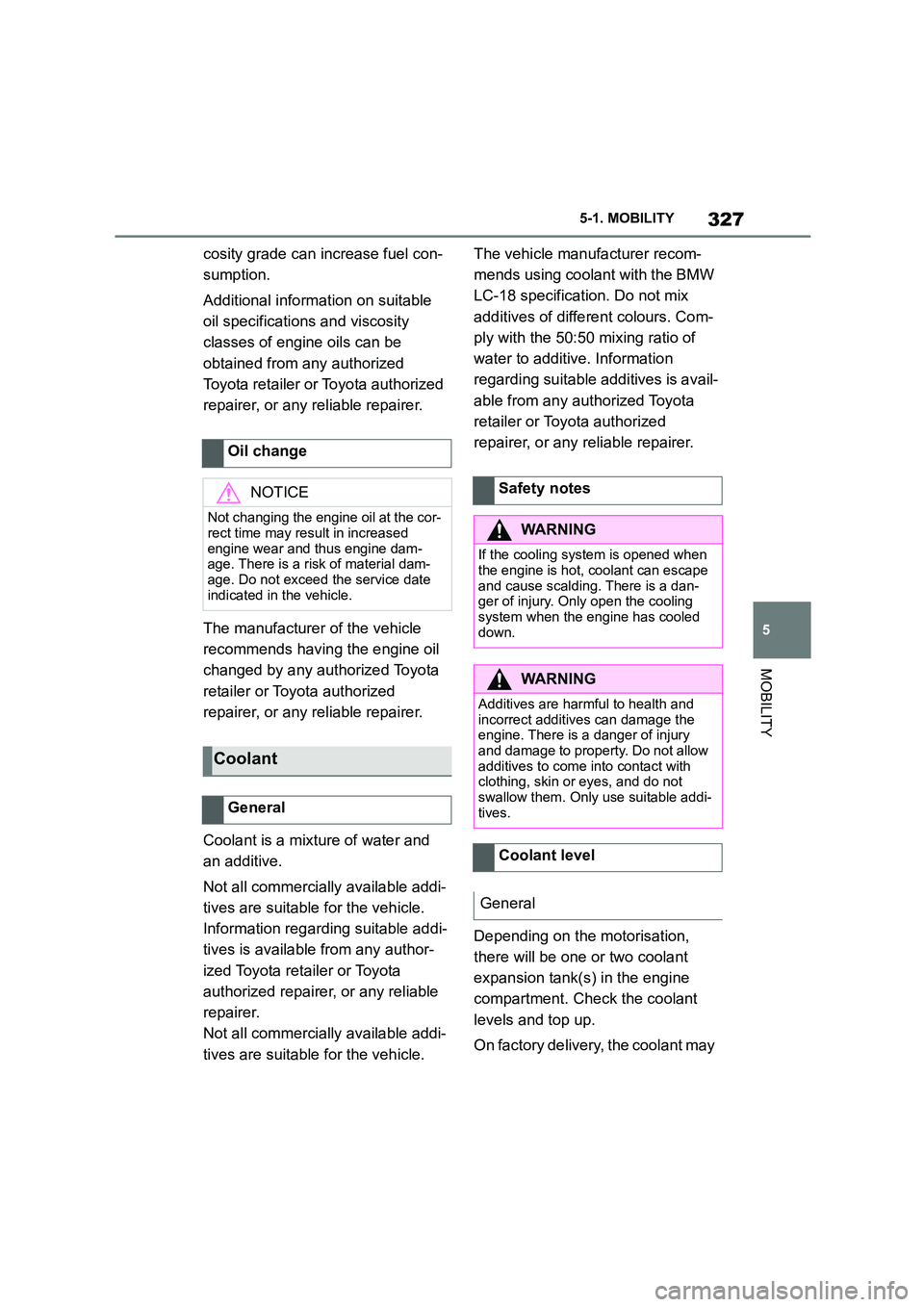
327
5
5-1. MOBILITY
MOBILITY
cosity grade can increase fuel con-
sumption.
Additional information on suitable
oil specifications and viscosity
classes of engine oils can be
obtained from any authorized
Toyota retailer or Toyota authorized
repairer, or any reliable repairer.
The manufacturer of the vehicle
recommends having the engine oil
changed by any authorized Toyota
retailer or Toyota authorized
repairer, or any reliable repairer.
Coolant is a mixture of water and
an additive.
Not all commercially available addi-
tives are suitable for the vehicle.
Information regarding suitable addi-
tives is available from any author-
ized Toyota reta iler or Toyota
authorized repairer, or any reliable
repairer.
Not all commercially available addi-
tives are suitable for the vehicle.
The vehicle manufacturer recom-
mends using coolant with the BMW
LC-18 specification. Do not mix
additives of different colours. Com-
ply with the 50:50 mixing ratio of
water to additive. Information
regarding suitable additives is avail-
able from any authorized Toyota
retailer or Toyota authorized
repairer, or any reliable repairer.
Depending on the motorisation,
there will be one or two coolant
expansion tank(s) in the engine
compartment. Check the coolant
levels and top up.
On factory delivery, the coolant may
Oil change
NOTICE
Not changing the engine oil at the cor-
rect time may result in increased
engine wear and thus engine dam- age. There is a risk of material dam-
age. Do not exceed the service date
indicated in the vehicle.
Coolant
General
Safety notes
WA R N I N G
If the cooling system is opened when
the engine is hot, coolant can escape
and cause scalding. There is a dan- ger of injury. Only open the cooling
system when the engine has cooled
down.
WA R N I N G
Additives are harmful to health and
incorrect additives can damage the
engine. There is a danger of injury and damage to property. Do not allow
additives to come into contact with
clothing, skin or eyes, and do not swallow them. Only use suitable addi-
tives.
Coolant level
General